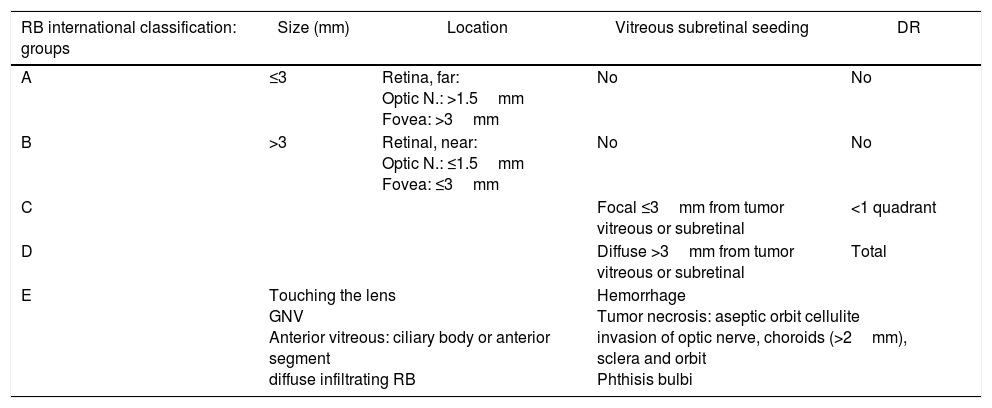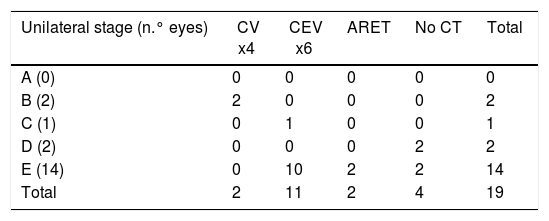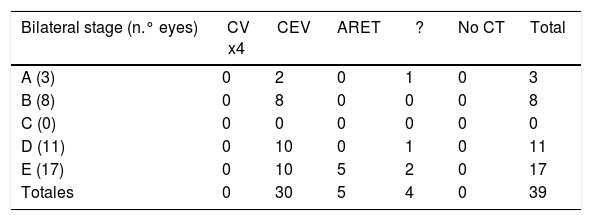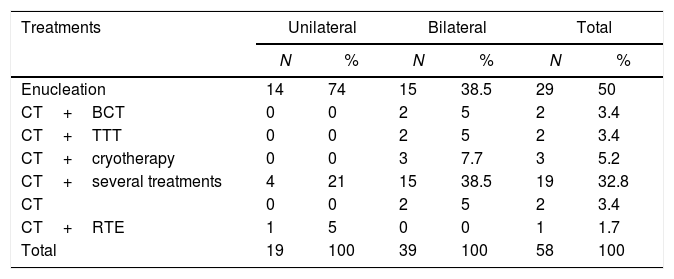Retinoblastoma is the most frequent malignant intraocular tumor in childhood, and both its cure and the sequelae arising from it, mainly depend on an early diagnosis. There is currently no consensus on its diagnostic and therapeutic management.
Patients and methodsA descriptive, retrospective, and non-randomised study was conducted on a series of cases (39 patients – 58 eyes), treated during the period 2006–2013, in the Regional Reference Center for Tumors of the National Health Service Quality Agency.
ResultsThe most frequent presentation sign is leukocoria (71.8%), followed by strabismus (17.9%). All cases of bilateral tumor had a germline mutation of the RB1 gene, and 20% had a family history. Stage E was observed in 55% of the patients, and 90% required chemotherapy treatment. The eye was maintained in 57% of those who had mild stages, compared to 43% who maintained it in advanced stages.
ConclusionsThis analysis included 58 eyes. There are no previous studies in our community and there are few series so numerous throughout the country. Based on non-standardised treatment, the most appropriate is chosen according to the characteristics of the tumor. The multidisciplinary management, formed by ophthalmology, pediatric oncology, radiotherapy, and radiophysical oncology, is fundamental for the selection of the most appropriate treatment. Chemo-reduction, along with consolidation treatments, offers encouraging results in the control of these tumors, especially in those of less severity. Enucleation continues to be the method of choice in the most advanced staging with vitreous involvement, with the importance of early diagnosis being highlighted.
El retinoblastoma es el tumor intraocular maligno más frecuente en la infancia y tanto su curación como las secuelas derivadas del mismo dependen fundamentalmente de un diagnóstico precoz. En la actualidad, no existe consenso en su manejo diagnóstico y terapéutico.
Pacientes y métodosEstudio descriptivo, retrospectivo, no aleatorizado, de serie de casos (39 pacientes-58 ojos), tratados durante el período 2006-2013 en nuestro servicio, nombrado centro de Referencia Regional de Tumores por la Agencia de Calidad del SNS.
ResultadosEl signo más frecuente de comienzo es la leucocoria (71,8%), seguido de estrabismo (17,9%). Todos los casos de tumoración bilateral presentaban mutación germinal del gen RB1 y un 20% tenían antecedentes familiares. El 55% de los pacientes presentaron estadio E, y el 90% precisó tratamiento quimioterápico. Un 57% de los que presentaban estadios leves, conservaron su ojo respecto al 43% que lo conservó en estadios avanzados.
ConclusionesEste análisis consta de 58 ojos, sin que existan estudios previos en nuestra comunidad y pocas series tan numerosas en todo el país. Basado en tratamiento no estandarizados, eligiendo el más adecuado según las características del tumor. El manejo multidisciplinar, formado por oftalmología, oncología pediátrica, oncología radioterápica y radiofísica, es fundamental para la elección de tratamiento más correcta. La quimiorreducción junto a tratamientos de consolidación ofrece resultados esperanzadores en el control de los mismos, sobre todo en los de menor severidad. La enucleación continúa siendo de elección en las estadificaciones más avanzadas con afectación vítrea, poniendo de manifiesto la importancia de su diagnóstico precoz.














